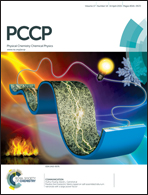Structures, electronic properties and stability phase diagrams for copper(i/ii) bromide surfaces
Abstract
This study presents a comprehensive periodic slab DFT investigation into structures, electronic properties and thermodynamic stability of all plausible terminations of CuBr and CuBr2 surfaces. We first estimate lattice constants, formation and cohesive energies for the two bulk copper bromides before proceeding to analyse geometrical and electronic features of CuBr and CuBr2 configurations. Surface geometries exhibit, to a large extent, corresponding bulk structures. Nevertheless, certain CuBr2 surfaces experience a downward displacement of the topmost Cu-containing layers. We plot total and projected density of states for bulk and surface geometries of these two copper bromides and calculate their associated Bader's electronic charges. Electronic structure analysis for the bulk and surfaces of these two copper bromides show that CuBr bulk and its most stable surface (CuBr(001)_Br) do not exhibit any metallic character, whereas CuBr2 bulk and its most stable surface (CuBr2(001)_Br) both exhibit metallic characters. The formalism of the ab initio atomistic thermodynamics affords the construction of energy phase diagrams. We predict that the CuBr(001) surface, truncated with Br atoms, is the most stable structure among the considered CuBr slabs at all physically meaningful ranges of the chemical potential of bromine. This surface resembles a c(2 × 2)-bromine sheet that was characterised experimentally from initial interaction of Br2 with a Cu(100) surface. We find that surfaces terminated with the electronegative bromine atoms, if accompanied by significant relaxation, tend to be more stable. Calculated surface energies predict the shapes of CuBr and CuBr2 nanoparticles as the chemical potential of bromine changes.


 Please wait while we load your content...
Please wait while we load your content...